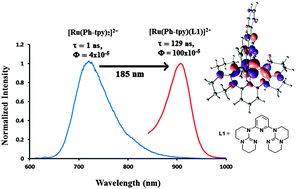Near infra-red emission from a mer-Ru(ii) complex: consequences of strong σ-donation from a neutral, flexible ligand with dual binding modes†
Abstract
A rare example of dual coordination modes by a novel tridentate ligand gives rise to unique fac-and mer-Ru(II/III) complexes. The mer-RuII-complex displays the farthest red-shift of a triplet metal-to-ligand charge transfer (3MLCT) emission with a tridentate ligand for a mononuclear complex. This observation is a consequence of large bite angle and strong σ-donation by the ligand, the combined effect of which helps to separate the energy of the 3MLCT and 3MC states.


 Please wait while we load your content...
Please wait while we load your content...